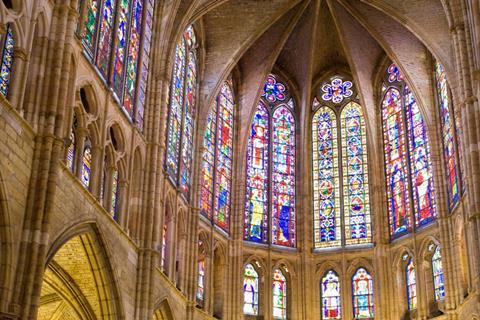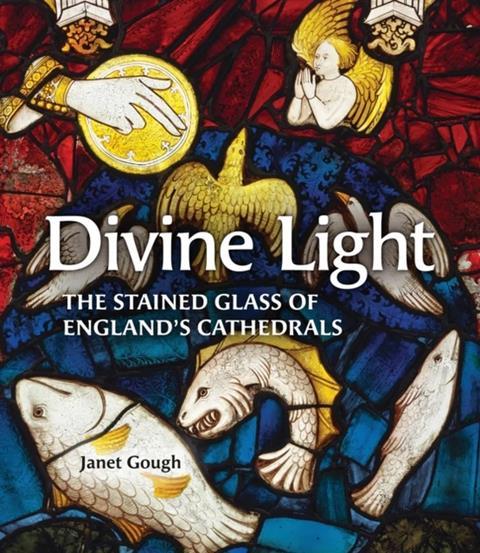Historian Janet Gough’s richly illustrated survey of stained glass in English cathedral reveals how this ancient art form continues to communicate biblical truth, says our reviewer

Before TikTok, Instagram and Facebook – before video, television and even colour photography – there was another powerful medium that illuminated people’s lives with the light of the Gospel: stained glass. And even in today’s fast-moving digital world, its beauty and influence continue to resonate with modern audiences.
Cathedrals and historic churches still have a magnetic pull for millions in the UK and around the world. Those churches that remain open during the week often find visitors drawn to them – to pray, reflect, or simply pause amid busy lives. I call them our “invisible congregation.”
These visitors may not attend church services, yet they wander through church buildings in search of something spiritual within an increasingly secular world. One of the enduring draws of these sacred spaces is their stained glass. In Divine Light (Kultaralis), historian Janet Gough explores examples from each of England’s cathedrals, uncovering the stories behind key works and revealing the timeless appeal of this luminous art form.
As Gough explains in this beautifully illustrated guide: “The stained-glass windows of England’s cathedrals illuminate interior spaces, communicate religious, historical and political messages, and perhaps offer us a glimpse of heaven.” That sense of awe and wonder infuses her writing – she communicates a deep enthusiasm for stained glass and seeks to inspire others to engage with the stories and symbolism behind this radiant art form.
To create this book – filled with vivid photographs of stained glass – Gough invited every cathedral in England, along with Westminster Abbey, St George’s Chapel and Windsor, to select one window to feature in her survey. The result is a vivid guide to 50 stained-glass windows, helping visitors better appreciate the works they encounter. It’s the kind of book you’ll find in cathedral gift shops – and one that would make a thoughtful gift for anyone drawn to church buildings but yet to encounter the Saviour they honour. It is gentle and beautiful way to awaken interest in the divine.

Gough approaches stained glass as a historian, architectural expert, and skilled Christian communicator – and her commentaries reflect all three perspectives as she uncovers the story behind each window.
Together, these insights form a well-produced, accessible guide to some of England’s finest stained glass, from Carlisle to Chichester, spanning the Middle Ages to the present day.
The oldest, dating from 1180, depicts Jesus’s parable of the Sower. The most recent example is Durham Cathedral’s window commemorating Sara Pilkington, a Durham University student who died from a cardiac condition. Dedicated in 2019, it has become a focal point for the cathedral’s student ministry.
From medieval to modern, each window draws the viewer into its story.
Earlier stained glass illustrated scripture for those unable to read it, turning cathedrals into ‘picture palaces’ of faith. Today’s designs are often more abstract, inviting emotional and spiritual reflection. Blackburn Cathedral’s 56 vibrant panes depict Christ as the Light of the World, while St Albans’ Rose Window – dedicated by Diana, Princess of Wales, in 1989 – shifts with the light, filling the space with colour and reverence.
A personal favourite is Bradford Cathedral’s Women of the Bible West Window (1864), depicting Mary, the mother of Christ; Mary Magdalene; Martha and Mary of Bethany; the Samaritan woman; and the angels proclaiming the resurrection.
There is much biblical truth to be found in stained glass windows for those who look with an inquiring mind. In many cases, knowledge of scripture helps decipher the stories being told. In others, the viewer is invited into an encounter with the divine – to look in awe and wonder at the artistry, and to feel an emotional response to what they see.
Stained glass may not be viewed by many evangelicals as a powerful means of communicating the gospel. We often look to words rather than images. Yet in our supremely visual age, these works of art – both ancient and modern – can capture the attention and imagination of the millions who are drawn to our cathedrals and historic churches.
This book shows that even in the age of Instagram and social media, stained glass still has a vital role to play in communicating the gospel and biblical truth.
Divine Light: The Stained Glass of England’s Cathedrals (Kultaralis) by Janet Gough is out now








































No comments yet